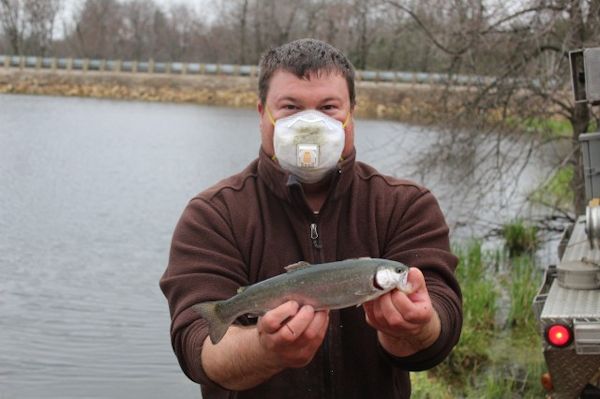SEJournal Online is the digital news magazine of the Society of Environmental Journalists. Learn more about SEJournal Online, including submission, subscription and advertising information.
 |
| COVID-19 isn't the only potential hazard as the 2020 fishing season begins; consumption advisories are another. Above, a U.S. Fish and Wildlife Service employee shows one of about 15,000 rainbow trout being stocked in Stillwell Lake, Fort McCoy, Wisc., in April. Photo: U.S. Army/Scott Sturkol. Click to enlarge. |
Reporter’s Toolbox: Consumption Advisories Offer Fistful of Fish Tales
By Joseph A. Davis
All over North America, people are throwing lines in the water for fishing season. And in this pandemic year, they’re engaged in a form of recreation that not only allows safe distancing but, for those with low or no income, a means to vital sustenance.
But not all of what they may catch is safe to eat. When lakes and streams are polluted, some fish may contain chemicals in amounts that are toxic.
How can fish-eaters know? We have some data for that.
Where the data comes from
Specific fish consumption advisories usually come from the states, territories and tribes that normally have front-line regulatory authority over water pollution and fishing rules.
Before 2011, the U.S. Environmental Protection Agency would collect and compile data on these advisories and publish it in a national online database. But since the more up-to-date and precise data was at the state level anyway, that’s possibly OK.
EPA still helpfully publishes a spreadsheet of all the state contacts for fish consumption advisories, which includes both phone numbers and web links (a searchable interactive mapping version is also available).
Start there for the most reliable and current information, but be aware that in some cases, the agency in charge is federal, like EPA or the National Park Service. There’s an additional access point for fish consumption advisory data for National Park System sites.
It is also worth remembering that most of the above data involves fish that ordinary land-locked citizens can catch themselves. Commercial fish, fish caught offshore and marine fish fall under a different regulatory scheme, with advisories issued by other agencies in these areas. Go to the Food and Drug Administration (FAQ).
The National Marine Fisheries Service (aka NOAA Fisheries) regulates commercial fisheries from a conservation and promotion standpoint, but does not usually address health concerns related to fish consumption.
How to use the data smartly
When sharing fish consumption advisories with your audience, it is worth remembering that warnings apply under specific conditions.
Some segments of the population may need to consume less of a particular kind of fish: for instance, those who eat fish every day, pregnant women, nursing women, children and the elderly.
The type of warning may also vary
according to the contaminant, which
might range from mercury to PCBs.
The type of warning may also vary according to the contaminant, which might range from mercury to PCBs. In some cases, as with filter-feeding shellfish, the contaminant may be a bacterium or virus.
A good advisory will be science-based and will be very specific about these things. Find general guidance on fish consumption and health from the EPA, along with links to other federal agencies that deal with fish consumption.
Most state agencies do a good job. But don’t assume all do. Some may downplay certain hazards for political reasons, so check with local health and toxicology experts.
Fish contamination problems are often long-lived. So historical information may be quite relevant if you are trying to assess risk. Fortunately, EPA has preserved and published some of this historical data. Its map-displayed database is searchable online, with a general search form.
Reporting Tip: Contamination of many inland waters lasts a long time because the contaminant is in the sediments. So one kind of meaningful environmental story can come from figuring out the original sources of contamination, then if they have been stopped and cleaned up.
[Editor's Note: For a related TipSheet, see: "Follow Fish Advisories To Catch Local Stories."]
Joseph A. Davis is a freelance writer/editor in Washington, D.C. who has been writing about the environment since 1976. He writes SEJournal Online's TipSheet, Reporter's Toolbox and Issue Backgrounder, as well as compiling SEJ's weekday news headlines service EJToday. Davis also directs SEJ's Freedom of Information Project and writes the WatchDog opinion column and WatchDog Alert.
* From the weekly news magazine SEJournal Online, Vol. 5, No. 24. Content from each new issue of SEJournal Online is available to the public via the SEJournal Online main page. Subscribe to the e-newsletter here. And see past issues of the SEJournal archived here.














 Advertisement
Advertisement 



